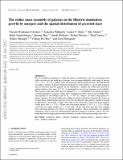The stellar mass assembly of galaxies in the Illustris simulation: growth by mergers and the spatial distribution of accreted stars
Author(s)
Rodriguez-Gomez, Vicente; Pillepich, Annalisa; Sales, Laura V.; Genel, Shy; Zhu, Qirong; Wellons, Sarah; Nelson, Dylan; Springel, Volker; Ma, Chung-Pei; Hernquist, Lars; Vogelsberger, Mark; Torrey, Paul A.; ... Show more Show less
DownloadThe stellar mass assembly of galaxies in the Illustris simulation.pdf (1.528Mb)
OPEN_ACCESS_POLICY
Open Access Policy
Creative Commons Attribution-Noncommercial-Share Alike
Terms of use
Metadata
Show full item recordAbstract
We use the Illustris simulation to study the relative contributions of in situ star formation and stellar accretion to the build-up of galaxies over an unprecedentedly wide range of masses (M* = 109-1012 M⊙), galaxy types, environments, and assembly histories. We find that the ‘two-phase’ picture of galaxy formation predicted by some models is a good approximation only for the most massive galaxies in our simulation – namely, the stellar mass growth of galaxies below a few times 10¹¹ M⊙ is dominated by in situ star formation at all redshifts. The fraction of the total stellar mass of galaxies at z = 0 contributed by accreted stars shows a strong dependence on galaxy stellar mass, ranging from about 10 per cent for Milky Way-sized galaxies to over 80 per cent for M* ≈ 10¹² M⊙ objects, yet with a large galaxy-to-galaxy variation. At a fixed stellar mass, elliptical galaxies and those formed at the centres of younger haloes exhibit larger fractions of ex situ stars than disc-like galaxies and those formed in older haloes. On average, ∼50 per cent of the ex situ stellar mass comes from major mergers (stellar mass ratio μ > 1/4), ∼20 per cent from minor mergers (1/10 < μ < 1/4), ∼20 per cent from very minor mergers (μ < 1/10), and ∼10 per cent from stars that were stripped from surviving galaxies (e.g. flybys or ongoing mergers). These components are spatially segregated, with in situ stars dominating the innermost regions of galaxies, and ex situ stars being deposited at larger galactocentric distances in order of decreasing merger mass ratio.
Date issued
2016-02Department
Massachusetts Institute of Technology. Department of Physics; MIT Kavli Institute for Astrophysics and Space ResearchJournal
Monthly Notices of the Royal Astronomical Society
Publisher
Oxford University Press
Citation
Rodriguez-Gomez, Vicente; Pillepich, Annalisa; Sales, Laura V.; Genel, Shy; Vogelsberger, Mark; Zhu, Qirong; Wellons, Sarah et al. “The Stellar Mass Assembly of Galaxies in the Illustris Simulation: Growth by Mergers and the Spatial Distribution of Accreted Stars.” Monthly Notices of the Royal Astronomical Society 458, no. 3 (February 26, 2016): 2371–2390.
Version: Author's final manuscript
ISSN
0035-8711
1365-2966